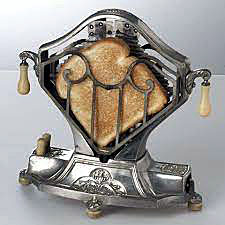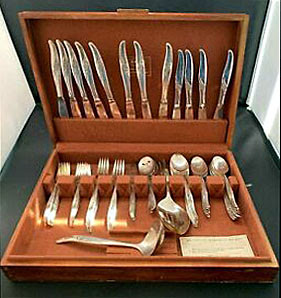 QUESTION: I recently saw an exquisite brooch made by Cartier at a charity antique show. I always associated Cartier with fine watches. Can you tell me more about Cartier and how the company got its start in the jewelry making business?
QUESTION: I recently saw an exquisite brooch made by Cartier at a charity antique show. I always associated Cartier with fine watches. Can you tell me more about Cartier and how the company got its start in the jewelry making business?
ANSWER: While most people associate the name Cartier with fine watches, the company actually began repairing fine jewelry and later creating it.
Louis-François Cartier founded Cartier in Paris in 1847 when he took over the workshop of his master, Adolphe Picard. In 1874, Louis-François' son Alfred Cartier took over the company, but it was Alfred's sons, Louis, Pierre and Jacques, who set up their own design and manufacturing operation and established the brand name worldwide.

Louis ran the Paris branch, moving to the Rue de la Paix in 1899. He was responsible for some of the company's most celebrated designs and exotic orientalist Art Deco jewelry, including the colorful "Tutti Frutti" jewels.
Cartier has had a long history of sales to royalty. King Edward VII of Great Britain referred to Cartier as "the jeweler of kings and the king of jewelers" For his coronation in 1902, Edward VII ordered 27 tiaras and issued a royal warrant to Cartier in 1904. Similar warrants soon followed from the courts of Spain, Portugal, Russia and the House of Orleans.

 The firm had always had an illustrious clientele, including Henri and Maurice de Rothschilde, Ira Nelson Morris, Florence Blumenthal, Daisy Fellowes, Mrs. Cole Porter and Barbara Streisand.
The firm had always had an illustrious clientele, including Henri and Maurice de Rothschilde, Ira Nelson Morris, Florence Blumenthal, Daisy Fellowes, Mrs. Cole Porter and Barbara Streisand.
The Cartier style was diverse, encompassing fashion accessories, as well as jewelry. It was a style which owed less to the prevailing design trends and more to the global travels and interests of the Cartier brothers and their intrigue with novelty. Their pioneering use of the much stronger platinum instead of silver, as a setting for diamonds made it possible to work in such a thin gauge that the diamonds seem to float in space in an intricate embroidery.
Attention to detail saw even the ring bolt catches studded with minute diamonds, and seed pearls on a tasseled pendant exquisitely graded in size.
 But Cartier made its jewelry to be adaptable. One diamond fern spray brooch could also be a long corsage, a necklace or a tiara. A central jeweled motif could be removed from a necklace and placed in a brooch setting which, with a tiny screw-driver, was packaged beneath the velvet of its padded box. Long necklaces, known as sautoirs, sometimes contained pendant watches and could be lengthened or shortened, even turned into Brooches were made to be divided, if desired, for wearing on each shoulder.
But Cartier made its jewelry to be adaptable. One diamond fern spray brooch could also be a long corsage, a necklace or a tiara. A central jeweled motif could be removed from a necklace and placed in a brooch setting which, with a tiny screw-driver, was packaged beneath the velvet of its padded box. Long necklaces, known as sautoirs, sometimes contained pendant watches and could be lengthened or shortened, even turned into Brooches were made to be divided, if desired, for wearing on each shoulder.
Pierre Cartier established the New York City branch in 1909, moving in 1917 to 653 Fifth Avenue, the Neo-Renaissance mansion of Morton Freeman Plant (son of railroad tycoon Henry B. Plant) and designed by architect C.P.H. Gilbert. Cartier bought it from the Plants in exchange for $100 in cash and a double-stranded natural pearl necklace valued at the time at $1 million. By this time, Cartier had branches in London, New York and Saint Petersburg.
 By 1910, Cartier had found another medium to work with-pieces of rock crystal, a colorless, hard stone which was carved with foliate scrollwork. Always open to experimenting with materials, the jewelers began using blackened steel as a setting for rubies and diamonds in 1913.
By 1910, Cartier had found another medium to work with-pieces of rock crystal, a colorless, hard stone which was carved with foliate scrollwork. Always open to experimenting with materials, the jewelers began using blackened steel as a setting for rubies and diamonds in 1913.
When the firm started to design its own jewelry, the Art Nouveau style of flowing, floral lines was at its peak. But Cartier chose to look back to historical Renaissance or Neoclassical architectural ornamentation for inspiration. A pendant in the form of an Ionic column, for instance, with scrolls from ancient stonework, is a good example. Cartier had a simplicity of design work with geometric patterns.
A trip to St. Petersburg in 1914 through 1915 and the popularity in the west of Faberge, inspired Cartier's Russian period. The trip was essentially to sell diamond and platinum jewelry and to purchase Russian enameled, gold objets d'art, but a year later Cartier had produced its own Russian style pieces and began exhibiting regularly in Russia, selling pieces to Russian nobility.

After the Russian Revolution, many of Faberge's American and European followers switched to Cartier, and this style continued to be produced until the 1920s.
 The overseas influence set a trend in Cartier design. The brothers' admiration of the past led to ancient designs from Egypt, Persia, India, China and Japan being reworked in a modern way. The discovery of the tomb of Tutankhamen in 1922 unleashed worldwide Egyptomania. Cartier produced pieces, such as a vanity box in the form of a sarcophagus. Designers looked to source books and museums, such as the Louvre and the British Museum, for inspiration.
The overseas influence set a trend in Cartier design. The brothers' admiration of the past led to ancient designs from Egypt, Persia, India, China and Japan being reworked in a modern way. The discovery of the tomb of Tutankhamen in 1922 unleashed worldwide Egyptomania. Cartier produced pieces, such as a vanity box in the form of a sarcophagus. Designers looked to source books and museums, such as the Louvre and the British Museum, for inspiration.
The collecting instincts of the Cartiers was evident in the way they included ancient fragments in their pieces, such as in a winged scarab brooch which included blue glazed wing pieces which would have been found on the chest of a mummy.
To read more articles on antiques, please visit the Antiques Articles section of my Web site. And to stay up to the minute on antiques and collectibles, please join the over 30,000 readers by following my free online magazine, #TheAntiquesAlmanac. Learn more about the Sears Catalogue and the items sold in it in "Sears' Book of Bargains" in the 2021 Fall Edition, online now. And to read daily posts about unique objects from the past and their histories, like the #Antiques and More Collection on Facebook.




















































